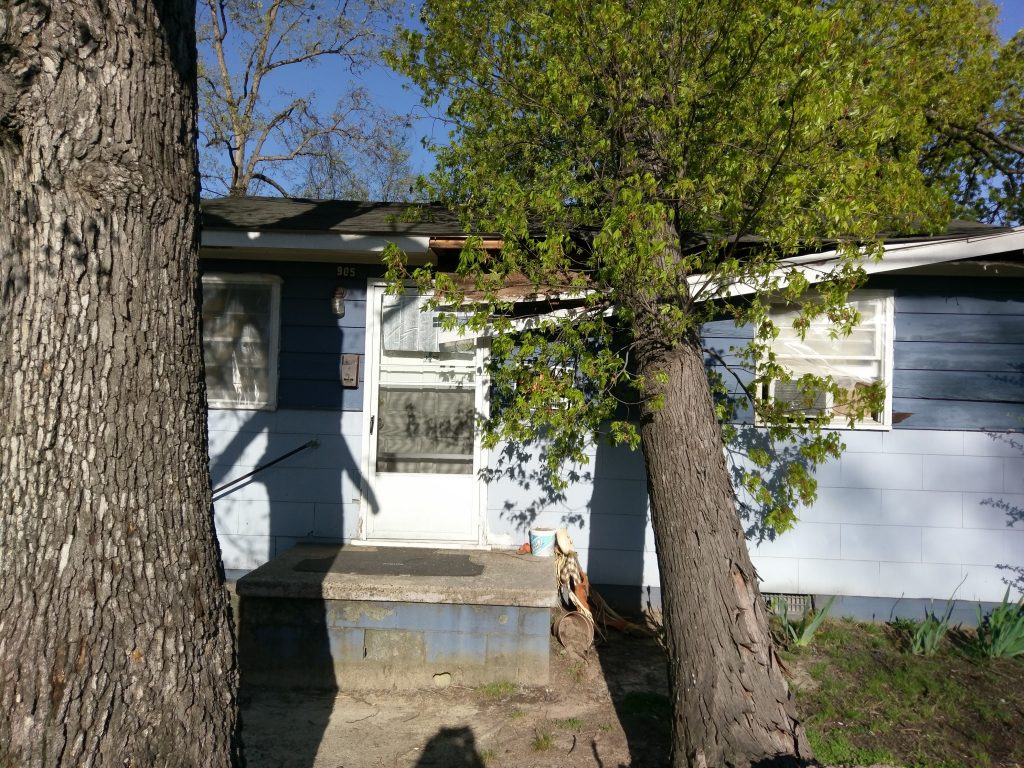
Weather disasters are ripping through communities in North Carolina and all over the world, dislocating people and devastating buildings and forests and farms. Each time, after the emergency response to dangers of injury and contamination and emotional trauma, the community is changed. Sometimes what is left is neglect and abandonment, so that unhealthy conditions become worse. Sometimes what happens is gentrification, so that dislocated residents cannot afford to come back to trendy buildings. But sometimes it can be community leadership, so that neighborhoods can rise stronger and healthier than before. This is the story of strong community and healthy housing six months after tornadoes shredded a path through east Greensboro.
Before April 15, 2018, asthma, vacancy, substandard housing, and poverty were clustered in eastern Greensboro. Mold and roaches made a large apartment complex in southeast Greensboro a hotspot for emergency department visits for asthma crises. Much of the city’s “affordable” housing was concentrated there but even the somewhat lower rents and mortgages were more than residents could afford. About a third of households live below the poverty line and two-thirds pay more than 30% of their income for housing costs.
On April 15, minutes after the devastating winds swept through, neighbors responded to help each other. In all, 1007 structures were damaged, 37 so severely they had to be demolished. Hundreds of people were displaced, at least temporarily.
For six months, the Storm Recovery Alliance has brought together organizations that counsel people about housing and financial problems with housing repair programs and community funders to coordinate shelter, services, and repairs. Community donations for assisting tornado victims totaled more than $700,000.
Now, Cottage Grove neighbors are passionately talking about what they want—or don’t want—built on the land where a deteriorating assisted living facility was wiped out. The neighborhood association’s president is looking forward to the completion of her new house, after her home for 29 years was lifted off its foundation. The apartment complex with so many asthma hospitalizations is being rehabilitated by its ambitious new owner and renamed “Cottage Gardens”, with new sewer lines and metal roofs.
We are at the intersection of community empowerment, housing, health, and investment. How did we get here?
1. For four years, the Cottage Grove neighborhood has been working on community-centered health, to develop the leadership to transform the environment and systems that make people sick. Neighbors have been learning to speak up, to prepare budgets and proposals for their own projects to improve health. They are moving from fear and concern that “If you could hear our voices, would we matter?” to persuading the zoning commission to deny a nuisance in the neighborhood.
2. To support significantly expansion of safe affordable housing, a wide range of community stakeholders advocated for housing bonds, which Greensboro voters approved in November 2016. Building new housing, preserving existing affordable housing, assisting tenants and homebuyers to access homes—and keep from losing them—requires substantial public, philanthropic, and investment resources. Broad community support for policy changes and for “Yes in My Backyard” development is essential for affordable housing near employment and schools. Code enforcement and legal counsel are necessary tools when property owners are unwilling to comply with minimum housing standards, tenant rights, and consumer protections.
3. Health system transformation incorporates “social determinants of health”, as medical providers broaden their focus from excellent medical treatment to housing and other environmental and economic factors. Mustard Seed Community Health, providing primary and behavioral health integrated with the Cottage Grove neighborhood revitalization, is a model for community health, so now there are two upstream clinics in the path of the tornadoes. Cone Health’s work towards healthy communities includes support for healthy housing. NC Department of Health and Human Services is developing pilot projects to incorporate housing, transportation, food, and other non-medical interventions in Medicaid managed care.
4. Investment in east Greensboro, the place to LIVE, WORK, PLAY, includes affordable housing. The Reinvestment Fund financed the purchase of Cottage Garden Apartments—its first investment in NC —through the InvestHealth collaboration funded by Robert Wood Johnson Foundation and is interested in finding more investment opportunities. The census tracts around the storm-smashed Hampton and Peeler schools have been designated Opportunity Zones by NC Department of Commerce as part of the federal tax changes. The direct financial Return on Investment may not be tremendous profits but the health and social benefits of fewer hospital emergency visits and fewer school moves and healthier communities.
Community-centered health. Safe affordable housing. Health system transformation. Investment. Put them all together for a stronger Greensboro after the tornado recovery. Then displaced neighbors will be able to return home to vibrant, healthy places where their voices are heard and their contributions valued, rather than the damaged areas becoming abandoned wastelands or gentrified gated communities.